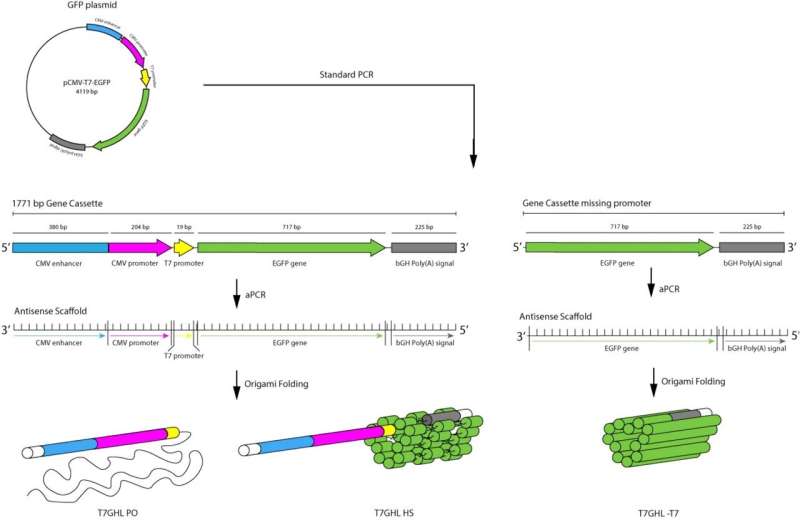This article has been reviewed according to Science X's editorial process and policies. Editors have highlighted the following attributes while ensuring the content's credibility:
fact-checked
trusted source
proofread
Building a DNA nanoparticle to be both carrier and medicine

Scientists have been making nanoparticles out of DNA strands for two decades, manipulating the bonds that maintain DNA's double-helical shape to sculpt self-assembling structures that could someday have jaw-dropping medical applications.
The study of DNA nanoparticles, however, has focused mostly on their architecture, turning the genetic code of life into components for fabricating minuscule robots. A pair of Iowa State University researchers in the genetics, development, and cell biology department—professor Eric Henderson and recent doctoral graduate Chang-Yong Oh—hope to change that by showing nanoscale materials made of DNA can convey their built-in genetic instructions.
"So far, most people have been exploring DNA nanoparticles from an engineering perspective. Little attention has been paid to the information held in those DNA strands," Oh said.
In a recent paper published in the journal Scientific Reports, Henderson and Oh described how they constructed DNA nanoparticles capable of expressing genetic code. Having gene-bearing capacity increases the potential of DNA nanotechnology.
"These structures could be both the carrier and the medicine," Henderson said.
Henderson and Oh said they are among the first research teams in the world to create a DNA nanoparticle that expresses its genetic code. The Iowa State University Research Foundation filed a patent application connected to the research in 2023.
Successful structures
Henderson came to Iowa State in 1987 but, for 14 years, split his time as he built a startup called BioForce Nanosciences. After returning to Iowa State full-time in 2008, he began working on DNA origami—a newly developed method of creating self-assembling complex nanostructures from long single strands of DNA.
Henderson and a former graduate student—Divita Mathur, now an assistant professor at Case Western University—designed a nanomachine biosensor that could detect pathogens.
That work left a lingering thought: What about the genes these structures carry? Could DNA origami express the genetic information integrated within itself?
The first step was figuring out how to create DNA origami with single strands that have specific genetic sequences, as opposed to the strands traditionally used to create nanoparticles.
That took a couple of years. Next up was determining if RNA polymerase, an enzyme for making RNA molecules from DNA codes, could navigate the extensive folds of DNA origami, Henderson said. A particular concern was whether polymerase would be blocked by crossovers, the junctions where long strands of DNA are connected by short bits of DNA called staples.
"It turns out they're not, which is counterintuitive," Henderson said.
While crossovers and complex architecture don't stop the RNA-making transcription process, the design of a DNA nanostructure does affect transcription efficiency. Dense structures produce less RNA, which implies nanoparticle design could be fine-tuned to inhibit or promote intended functions, Oh said.
"We could make an efficient, targeted delivery system that has potential in many fields, including cancer therapy," he said.
Affordable and durable
The potential for precision is part of what makes DNA nanoparticles an exciting possibility, Henderson said.
"Gene editing is incredibly powerful, but one of the hardest parts of editing genes is only editing the genes you want to edit. So that's the dream, to finesse these nanoparticles to target certain cells and tissues," he said.
However, DNA nanoparticles have other major advantages. They are easy to make, inexpensive, and durable. Making nanoparticles self-assemble is as simple as heating a mixture and letting it cool, with no special equipment needed, Oh said.
Thanks in part to the ubiquity of DNA research, strands and staples are inexpensive to produce. Despite using them daily, Henderson and Oh are still working their way through a package of staples purchased from a Coralville manufacturer several years ago for a few hundred dollars.
And the components, which can be stored as a powder, have a long shelf life, even in the most challenging conditions, Henderson said. It's a technology that could easily spread.
"DNA is very stable. It's been recovered from samples more than 1 million years old," he said.
More information: Chang Yong Oh et al, In vitro transcription of self-assembling DNA nanoparticles, Scientific Reports (2023). DOI: 10.1038/s41598-023-39777-0
Provided by Iowa State University




















